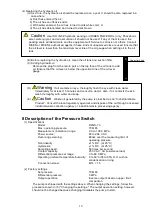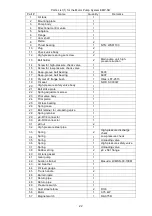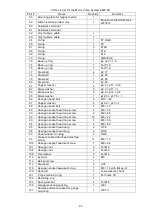
15
9 Operation Method
(1) EMP-5B
The EMP-5B is equipped with a manual three-way poppet valve (EHV-3). When the lever is
tightened, the tank port closes so that the hydraulic oil is discharged. When it is loosened, the
tank port opens so that the oil returns to the oil tank.
Example of use with a single-acting cylinder (spring return type)
Connect the discharge port and cylinder using a high-pressure hose.
(A) Loosen the lever of the directional control valve.
(B) Turn the activation switch (SW) “ON” to activate the motor.
(C) Tighten the lever of the directional control valve.
(D) The piston comes out to start operation and raise the pressure.
(E) The motor stops when the pressure rises to the set pressure, and restarts
automatically when the pressure drops to the set differential pressure.
(F) To retract the piston, loosen the lever.
(G) When finishing the operation, retract the piston and turn the activation switch (SW)
“OFF” to stop the motor.
* If a malfunction occurs, immediately turn the activation switch (SW) “OFF” to stop the
motor.
(2) EMP-5C
The directional control valve installed in the EMP-5C is a manual, four-way, three-position
directional valve (EHV-4). When the lever is at the center position, the hydraulic oil
discharged from the pump returns to the oil tank. The pump discharges the oil to Port A when
the lever is at the left side seen from the front of the pump or to Port B when the lever at the
right side.
Example of use with a double-acting cylinder:
There is no differentiation between Ports A and B. Assume that Port A is connected to the
push side and Port B to the pull side.
(A) Set the lever of the directional control valve to the center position.
(B) Turn the activation switch (SW) “ON” to activate the motor.
(C) Slide the lever of the directional control valve to the left side.
(D) The piston comes out to start operation and raise the pressure.
(E) The motor stops when the pressure rises to the set pressure, and restarts
automatically when the pressure drops to the set differential pressure.
(F) When the lever is at the center position, the pressure decreases, causing the motor to
start.
(G) To retract the piston, slide the lever to the right side.
(H) When the piston has completely retracted, slide the lever to the center position.
(I) When finishing the operation, retract the piston and set the lever of the directional
control valve to the center position. Then, turn the activation switch (SW) “OFF” to
stop the motor. Slide the lever of the directional control valve rightward and leftward to
remove the residual pressure from the high pressure hoses.
* During switching of the directional control valve (EHV-4), the pressures at Ports A and B
decrease to 0.
* If a malfunction occurs, immediately set the lever of the directional control valve to the
center position and turn the activation switch (SW) “OFF” to stop the motor.













































